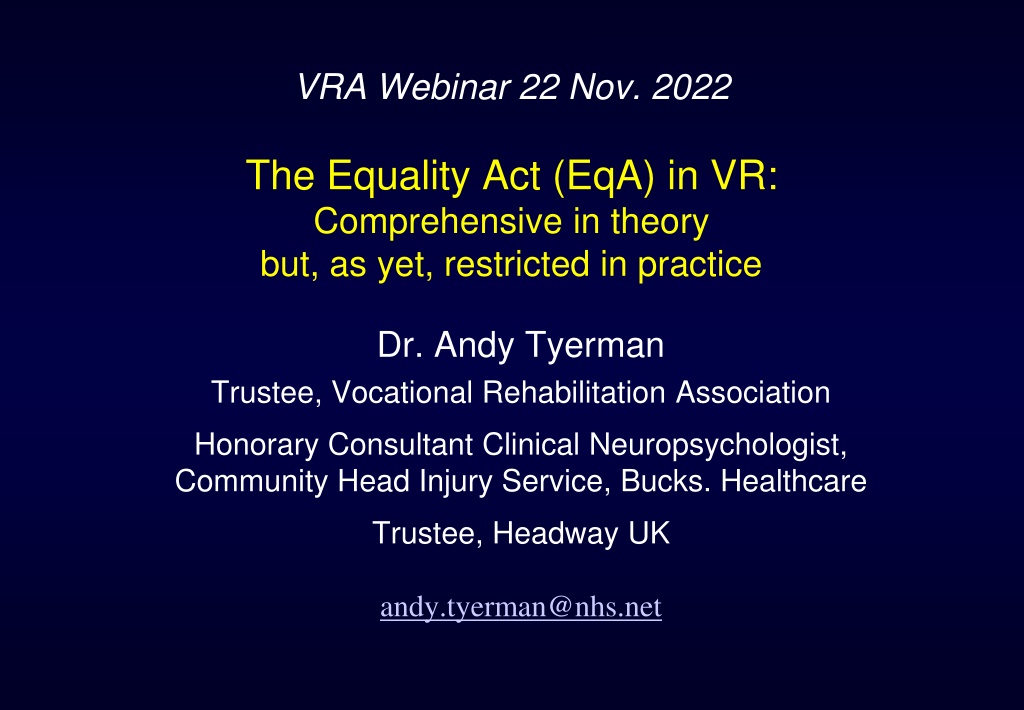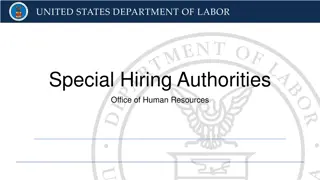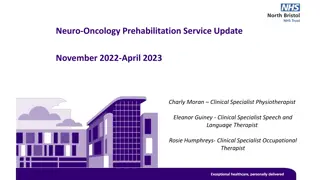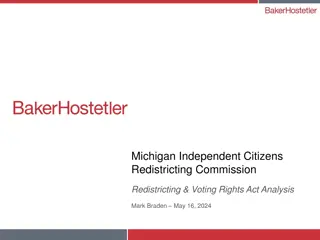
Understanding Equality Act 2010 and VR Implications
Explore the core definitions of the Equality Act 2010, focusing on disabilities, long-term effects, and normal day-to-day activities. Dr. Andy Tyerman discusses the comprehensive theory of the Equality Act in vocational rehabilitation, highlighting its restrictions in practice and implications for VR. Gain insights into forms of discrimination, employers' obligations, and examples of acquired and developmental disabilities, offering valuable conclusions for the Vocational Rehabilitation field.
Download Presentation

Please find below an Image/Link to download the presentation.
The content on the website is provided AS IS for your information and personal use only. It may not be sold, licensed, or shared on other websites without obtaining consent from the author. If you encounter any issues during the download, it is possible that the publisher has removed the file from their server.
You are allowed to download the files provided on this website for personal or commercial use, subject to the condition that they are used lawfully. All files are the property of their respective owners.
The content on the website is provided AS IS for your information and personal use only. It may not be sold, licensed, or shared on other websites without obtaining consent from the author.
E N D
Presentation Transcript
VRA Webinar 22 Nov. 2022 The Equality Act (EqA) in VR: Comprehensive in theory but, as yet, restricted in practice Dr. Andy Tyerman Trustee, Vocational Rehabilitation Association Honorary Consultant Clinical Neuropsychologist, Community Head Injury Service, Bucks. Healthcare Trustee, Headway UK andy.tyerman@nhs.net
Outline Equality Act (EqA) definitions / forms of discrimination Employers obligations (selection & ongoing employment) Examples: acquired (ABI) + developmental (ASD/dyslexia) Float some draft conclusions + implications for VR Key sources, other reading, references & abbreviations. Rely on EqA 2010 Employment Statutory Code of Practice (EHRC, 2011). Personal views: no legal training, not legal advice. Primary concerns: unfulfilled work potential + psychological impact
Equality Act (EqA) (2010) Core definitions Disability : a physical or mental impairment which has a long-term and substantial adverse effect on the ability to carry out normal day-to-day activities . (para 2.12). Mental impairment is intended to cover a wide range of impairments relating to mental functioning, including learning disabilities. (App. 1 para 6) . No need to establish a medically diagnosed cause for impairment, it is the effects that matters (App. 1, para 7) Guidance on disability definition (Office for Disability Issues, 2011).
Long-term / Substantial Long-term - impairment has lasted or is likely to last for at least 12 mons. or for rest of life (para 2.14). Even when no longer adversely affected in daily activities, still protected if effects lasted for over 12 mons. (para 2.9). Substantial means more than minor or trivial (para 2.15). A substantial adverse effect reflects general understanding of disability as a limitation beyond normal differences in ability When taking measures to treat/correct effect and, but for this, likely substantial adverse effect . still to be treated as though it has that effect, except glasses/contact lenses to correct eyesight (para 2.16)
Normal day-to-day activities Activities carried out by most people on a fairly regular or frequent basis .. This includes but is not limited to walking, driving, using public transport, cooking, eating, lifting & carrying everyday objects, typing, writing (& taking exams), going to toilet, talking, listening to conversations or music, reading, normal social interaction or forming social relationships, self- nourishing / caring and activities relevant to working life. (App 1, paras 15).
.cont. Normal day-to-day activities Impairment may not prevent day-to-day activities but still have substantial adverse effect on how they carry out those activities: May suffer pain; or more than usual fatigue so not be able to continue over sustained period of time. (App.1, para 10) Good practice: for employers & Occupational Health to focus on any reasonable adjustments (RA) needed even if there is doubt about whether person falls within definition of disabled person. (para 10.43).
Six forms of Disability Discrimination Direct discrimination Indirect discrimination Discrimination arising from disability Duty to make reasonable adjustments Harassment Victimisation (Equality & Human Rights Commission [EHRC], 2011).
Direct discrimination - disability Treat person less favourably than they treat (or would treat) others: because of a disability (para 3.2), based on stereotype relating to a disability (para 3.15) or because of association with person with disability, campaigned to help or refused to act in a way that would disadvantage such a person (paras 3.18-3.20). because mistakenly think a worker has a disability (para 3.21). Unlawful, regardless of motive, intent, whether done consciously or unconsciously or whether the employer is aware of treating the worker differently (para 3.14) .
Indirect discrimination. Apply an apparently neutral provision, criterion or practice which puts workers with a disability at a particular disadvantage (para 4.3) This includes any policies, rules, practices, arrangements, criteria, conditions, prerequisites, qualifications or provisions (para 4.5). Disadvantage includes denial of opportunity or choice, deterrence, rejection or exclusion: does not have to involve actual loss (para4.9) does not have to be intentional (para 4.24). Employer cannot show that the provision, criterion or practice is a proportionate means of achieving a legitimate aim. (para 4.4)
Discrimination arising from disability... Duty not to treat disabled people unfavourably because of something connected with disability(e.g. dismissal as a result of disability-related sick leave rather than disability itself) (para 5.3). Treatment of a disabled person amounts to discrimination where: an employer treats the disabled person unfavourably .because of something arising in consequence of a person s disability; & cannot show a proportionate means of achieving a legitimate aim. Unless the employer does not know, and could not reasonably be expected to know, that the person has the disability. (Para 5.2)
Duty to make reasonable adjustments 1. Employers required to take positive steps to ensure that people with disability can access and progress in employment. (para 6.2) Not only avoiding treating people with disability unfavourably, but also taking additional steps to ensure they can access jobs, education and services as easily as people without disability (para 6.2): e.g: allowing several short breaks instead of one longer break fatigue. The aim of making adjustments is, as far as possible, to remove any disadvantage faced by disabled people. (EHRC, 2020).
Reasonable adjustments (RA) 2. Employers are required to take reasonable steps to: Avoid substantial disadvantage arising from a provision, criterion or practice applied by or on behalf of employer. Remove or alter a physical feature or provide a reasonable means of avoiding such a feature .. Provide auxiliary aid (including auxiliary service) where put at substantial disadvantage but for that provision. (para 6.5) No onus on employee to suggest what RA should be made (para 6.24) If H&S concern, risk assessment should be undertaken (para 6.27).
RA 3. Factors Factors which might be taken into account when deciding what is a reasonable step include the following (para 6.28): likely effectiveness in preventing disadvantage the practicability of the step financial & other costs of adjustment & extent of any disruption the extent of employer s financial or other resources financial or other assistance to help employer make adjustment the type and size of the employer
RA 4. Implementation Effective RAs often involve little or no cost or disruption and are therefore very likely to be reasonable to have to make unless another factor (eg. impractical / ineffective) make it unreasonable (para 6.5) Even if significant cost, may be cost-effective (e.g. relative to recruiting & training new staff member) (para 6.25) and also more likely to be reasonable if organisation has substantial financial resources. NB resources as a whole, not specific service. Easier to implement, more likely to be reasonable; however just because difficult does not mean it cannot also be reasonable.
RA 5 Reasonable - legal judgment When duty applies, reasonableness alone determines whether has to be made this depends on individual circumstances (paras 6.30) Not personal opinion - legal judgment about what is reasonable to implement but why would you not make the RA anyway ? Good starting point to assess, with person, what RA are required. Having taken all relevant issues into account, if decide adjustment is reasonable, then must make RA, otherwise committing an act of unlawful discrimination > right to claim to Employment Tribunal (para 6.31-32). (NB Time limits for legal claims; paras 15.20-31).
Disabilityrelated Harassment Occurs when unwanted conduct related to disability has purpose or effect of violating dignity of a person or of making them feel humiliated, offended or degraded (para 7.6). This could be spoken or written words or abuse, imagery, graffiti, physical gestures, facial expressions, mimicry, jokes, pranks, acts affecting a person s surroundings or other physical behaviour (para 7.7). Deciding whether conduct had effect ; requires consideration of : circumstances of person with disability, environment in which it occurred, and whether it is reasonable to have that effect (para 7.18).
Disabilityrelated Victimisation Subjected to a detriment because of making (or supporting) a complaint of discrimination (para 9.2). This includes Protected acts : bringing proceedings under the EqA giving evidence or information in connection with EqA doing anything related to the provisions of the EqA making allegation person has acted in breach of EqA making/seeking relevant pay disclosure (para 9.5) Also unlawful to instruct or to help, cause or induce (or attempt to cause or induce) a person to discriminate against, harass or victimise third person because of disability or a protected act (para 9.16-17)
Obligations of employers in selection 1 Assess objectively for ability to do job and not discriminate against or victimise job applicants with disability (para 10.7) in: arrangements for deciding who offered employment; in the terms on which they offer employment; or by not offering employment to the applicant. Arrangements - all policies, criteria & practices incl. adverts, application & interview, not just decision-making (para 10.8). Might mean providing/accepting information in accessible formats or amending policies / procedures to reduce disadvantage. (para 10.18).
Obligations in Selection 2. Health Enquiries With exception of enquiries to determine RAs, employers should not make enquiries about disability/health before job offer (para 10.10). Information obtained for purpose of adjustments should.....be held separately & not form any part of decision-making (para 10.29). If disability voluntarily disclosed, must only ask further Qs about RAs required to carry out an intrinsic function of job (para 10.37) . Job offers can be conditional on satisfactory responses to disability or health enquiries / checks but must not discriminate on that basis. (para 10.39)
Obligations of employers to employees 1 Must not discriminate against employee with disability in: Terms of employment: pay, hours, bonuses, pensions, sickness, leave Access to opportunities (i.e. promotion, transfer, training etc.) Dismissal; or any other detriment (para 10.11-10.17). Policies & procedures may need to be amended to ensure employees with a disability are not put at a substantial disadvantage. Duty to make RAs applies to all stages of employment and should be implemented in a timely fashion (para 6.32). Some RA require cooperation of co-workers. If staff obstructive or unhelpful employer expected to deal with this appropriately (para 6.35).
Obligations to employees 2a Reasonable Steps Examples of steps it might be reasonable to take include: Making adjustments to premises Providing information in accessible formats Allocating some duties to another worker Altering hours of work or training Transferring worker to fill an existing vacancy Assignment to different place of work and/or home-working Allowing absence from work to attend for rehabilitation, assessment or treatment Training or mentoring (for person or others) .. cont.
cont. Examples of Reasonable Steps 2b Acquiring or modifying equipment Modifying procedures for testing or assessment Providing a reader or interpreter Providing supervision or other support Allowing a disabled worker to take period of disability leave Participating in supported employment schemes Employing a support worker to assist a disabled worker Modifying disciplinary or grievance procedures Adjusting redundancy selection criteria Modifying performance-related pay arrangements (para 6.33)
ABI examples of discrimination 1. Told by senior executive would not employ anyone with ABI ! Voluntary work enquiry - told we ve already got one of those ! Work experience: H&S too risky , without any discussion of RA. Clients offered a salary below minimum wage Ignoring advice on permitted earnings rules > risking benefits Former Two Tick employer - meet minimum criteria - no interview. Follow-up enquiries often ignored or dismissed. + NHS job specs still require car driving just to travel between sites + Adjustment requests ignored (e.g. for a year by 3 managers) . Cont.
ABI examples of discrimination 2. pressure to work overtime in spite of fatigue, risking health/job very slow response to concerns, exacerbating anxiety/distress. refusing requests to meet VR staff to explain difficulties and for a person with communication difficulties at a disciplinary hearing refusing VR support at work even when job at risk. Even if rebuffed contact with employer may be beneficial as aware of involvement of people with knowledge of employee rights and may lead to change in attitude and more positive relationship. Without access to VR support, people very commonly struggle and often unable to secure the reasonable adjustments that they need.
A more positive ABI example A person receiving couples therapy very late post ABI facing dismissal following alleged gross misconduct (reporting error). Contacted HR to explain error likely reflect current stress on top of effects of ABI when fatigued at end of day (unlikely misconduct). Hearing postponed > on leave pending OH assessment / report. Vocational assessment > recommended RAs. Detailed report to Occupational Health and meeting with employer & HR. Redeployed in reduced role on protected pay. Experienced micro- management : Support in adjusting to new role - monthly for 2 yrs > quarterly > 6 monthly > annually to secure & maintain job. (from Tyerman et al., 2017, example D).
Developmental conditions - a few examples Delayed response / refusal to provide RA at interview multiple examples incl. request to prepare presentation day before interview Multiple examples of long delays in implementation of RA, e.g. RA not in place by 6 mons employee left post psychological impact > sickness absence > grievance / legal claim Failure to report sickness absence as being disability-related Decline to continue dyslexia RA from last role as passed own test + Other multiple other examples, subject of active legal claims
Public Sector Equality Duty (PSED) Consider needs of all individuals in policy, delivering services & for own employees so that appropriate & accessible to all. Public bodies required to have due regard to the need to: eliminate unlawful discrimination, harassment, victimisation and any other conduct prohibited by EqA advance equality of opportunity between people with a disability and those without foster good relations between people with a disability and people without. (EHRC, 2014/2021)
PSED 2: Advancing equality of opportunity . .involves consideration of the need to: remove or minimise disadvantages of people with a disability; meet the needs of people with a disability; and encourage participation in public life or other activities if low. Recognise the needs of people with a disability and take this into account in policies/services including making reasonable adjustments in order to meet their needs. (EHRC, 2014/2021)
NHS, HCPC & VRA Practitioner Standards NHS Const.: duty not to discriminate against patients or staff & to adhere to equal opportunities & equality human rights legislation. HCPC: not discriminate against service users, carers or colleagues by allowing your personal views to affect your professional relationships or the care, treatment or other services you provide; > challenge colleagues if you think they have discriminated against, or are discriminating against, service users, carers and colleagues VRA: Accommodate differences due to age, disability, gender reassignment, marriage & civil partnership, pregnancy & maternity, race (incl. colour, nationality, and ethnic or national origin), religion or belief, sex (gender) & sexual orientation.
House of Lords Select Committee: EqA 2010 & Disability (2016) Problems with RA in almost every part of society . Highlight poor understanding of employers duty to reduce disadvantage to achieve equality in practice (para 204-6), some still see as favouritism . Some still believe only applies to physical/sensory disability (para 207-8). House of Lords Liaison Committee (2021): Many concerns > 19 recommendations govt., PSED, RA & access to justice. Women & Equalities Committee (2019a): What little enforcement is happening insufficient to tackle systemic or routine discrimination that too many people experience as a simple fact of life . Highlight need for a fundamental shift in enforcement of the EqA.
Misuse of Non-Disclosure Agreements (NDAs) WEqC (2019b) also raise serious concerns of employers covering up allegations of workplace discrimination through NDAs. Employees often feel have to sign but then may find it difficult to work in same sector and/or suffer psychologically or financially. NDAs should not be used to silence victims of discrimination and harassment and that employers and their legal advisers should not be complicit in using NDAs to cover up allegations of unlawful acts . FoI request English NHS Trusts by Health Service Journal: 2018-21 247 settlement NDAs (excl. non-responders) but number is falling.
Ableism and the Labour Market Why Are 48,000 Disabled Workers Managed out of Work every year ? Employment Tribunals (ETs) far from ideal - legal representation needed to navigate system but prohibitively expensive for most ..... ET experience frequently traumatising - legal advice often to settle asap to reduce trauma > smaller settlement + no impact on case law. Disability-positive framework involves changing hearts & minds : View all employees as talent to be nurtured and prioritise health & wellbeing incl. offering workplace adjustments to all, Act creatively to remove barriers and facilitate inclusive workplaces (Association of Disabled Professionals, 2022)
Some unhelpful responses to complaints / claims Delayed and/or inconsistent response (NB time limits for claim) Not agreeing with or implementing OH recommendations Disputing medical and/or psychological reports / demanding re- assessments to re-confirm diagnosis and/or disability. Even when appears clearcut, may not be resolved: denial of EqA jurisdiction, attempts to reframe or justify action / inaction ! Further discrimination / harassment / victimisation > resignation Inaccurate/misleading evidence provided to investigations Spiralling & often prohibitive legal costs Lack of RA in legal proceedings > further discrimination
Successful RA legal claims some examples: Refusal to vary standard assessment test or format Refusal to provide a dedicated parking space Not making adjustments, as none recommended by GP Failure to recognise disadvantage > inefficiency Recommended training delayed > dismissal on capability grounds Insufficient adjustments provided > do job but not to best of ability Declining a request to transfer to another role - RA required Disability leave adjustment removed > leading to dismissal Failure to maintain rate of pay on disability redeployment
One ABI practitioners draft conclusions EqA: comprehensive requirements but poorly understood. Discrimination common - lack of implementation / enforcement Complex / protracted complaints, grievance & appeals procedures Raising concern / legal action often leads to more discrimination, harassment and/or victimisation > psychological impact Regulatory bodies seem reluctant to regulate discrimination. Ongoing VR support if person decides to take action. However Few can afford cost of legal representation or taking legal action. Wasted potential, high cost & risk of psychological damage
Discrimination > Psychological Concerns Stress & frustration of action on top of original discrimination + Disappointing response (often challenging, sometimes aggressive) + Questioning of diagnosis, impairment, disability or disadvantage Significant impact on psychological well-being, e.g. after ABI undermining progress in insight and awareness into difficulties reinforcing belief that no-one outside family & ABI understands loss of confidence in ability to work, if no adjustments agreed reduction in job search / applications / employment Increased social isolation, depression & suicidal thoughts / actions Need for collective action !
Reflections for VR practice: 1. Person Immediate advice / support in response to reported discrimination. Being alert to potential impact on psychological well-being + referring for support, as & when required. Signposting to advice on EqA, as appropriate (e.g. CAB, EASS, EHRC, DRUK, solicitors, Union, TUC, voluntary groups, VRA). Support in weighing implications and pros & cons of planned action - VR support to find alternative job is often a safer option. Provision of reports to inform any grievance or legal action. Ongoing support for any such process & after-effects, as required.
Reflections for VR practice: 2. Employers In response to reports or observations of discrimination .. Signposting to sources of EqA advice for employers: (e.g. ACAS, Business Forum on Disability, CIPD, EHRC, HSE, OH) Offer of support in response to above information/advice + Where concerns of D remain: As discussed & agreed with person Raise concern with employer: Avoid D word (Discrimination) & E word (Equality), focus on F for Facilitation, facilitating for... person - Adjustments, Belief, Confidence > Psychological W/B employer - Performance, Resolution & Stability > Productivity As rqrd, statement of disability, concerns & options for resolution
Reflections for VR practice: 3. Practitioners Aim: Support people with disability in achieving vocational goals: Need HCP/VR practitioners to be alert to & address EqA issues Core EqA training - disability + information sources (incl. VRA) Survey of VR practitioners EqA experiences / training needs Pooling of +ve. and ve. examples to guide VR practice + For those responding to EqA concerns: Development of in-depth training (incl. detailed examples) Specialist supervision / mentoring / peer support Research on psychological impact of complaints / legal cases Pan-disability, inter-disciplinary, multi-agency group to guide, promote & support implementation of EqA in VR. RSVP
Key source material EHRC (2011). Equality Act 2010 Employment Statutory Code of Practice. London: Equality and Human Rights Commission. https://www.equalityhumanrights.com/sites/default/files/employercode.pdf House of Lords Select Committee (2016) Equality Act 2010 and Disability. Report of House of Lords Select Committee. https:// www.publications.parliament.uk/pa/ld201516/ldselect/ldeqact/117/117.pdf Office of the United Nations High Commissioner for Human Rights (2012). Thematic study on the work and employment of persons with disabilities. http://www.ohchr.org/_layouts/15/WopiFrame.aspx?sourcedoc=/Documents /Issues/Disability/A-HRC-22- 25_en.doc&action=default&DefaultItemOpen=1 Accessed on line16/05/17 Tyerman A, King N & Hillier M (2020). Return to work and vocational rehabilitation p 399-446. In M Van Den Broek, S Sembi (eds) Brain injury claims. London: Thomson Reuters / Sweet & Maxwell
Other recommended reading Association of Disabled Professionals (2022). Ableism and the Labour Market. S. Kumar & C. Provost for Association of Disabled Professionals. Landon M & Williams T (2019). The Equality Act 2010 in J. Hobson & J. Smedley (eds.) Fitness for Work: The Medical Aspects (6ed.). Oxford: OUP. https://doi.org/10.1093/med/9780198808657.003.0003 EHRC (2011). Equality Act 2010: Services, public functions and associations Statutory Code of Practice. London: Equality & Human Rights Commission. https://www.equalityhumanrights.com/sites/default/files/servicescode_0.pdf EHRC (2014). Equality Act 2010: Technical Guidance on Further & Higher Education. London: Equality & Human Rights Commission. https://www.equalityhumanrights.com/sites/default/files/equalityact2010- technicalguidance-feandhe-2015.pdf
Other references House of Lords Liaison Committee (2021) The Equality Act 2010 and Disability the impact on disabled people: Follow-up report. Office for Disability Issues (2011). Equality Act 2010: Guidance on matters to be taken into account in determining questions relating to the definition of disability. London: Office for Disability Issues. Tyerman A, Meehan M & Tyerman R. (2017). Vocational and occupational rehabilitation. P 378-388. In B. Wilson, J Winegardner, C. van Heugten & T Ownsworth (eds.) Neuropsychological Rehabilitation: The International Handbook. Psychology Press. Women and Equalities Committee (2019a). Enforcing the Equality Act: the law and the role of the EHRC. + (2019b). The use of non- disclosure agreements in discrimination cases. House of Commons.
Abbreviations 1 ABI Acquired brain injury EHRC Equality & Human Rights Com ET Employment Tribunal EqA Equality Act H&S Health & Safety HSJ Health Services Journal OH Occupational Health NDA Non-Disclosure Agreement PSED Public Sector Equality Duty RA Reasonable Adjustments VR Vocational Rehabilitation ACAS Arbitration & Conciliation Service BFD Business Forum on Disability CAB Citizens Advice Bureau CIPD Chartered Institute Personnel Dev. DRUK Disability Rights UK EASS Equality Advisory & Support Serv. HCPC Health & Care Professionals Coun HSE Health & Safety Executive TUC Trade Unions Council VRA Vocational Rehabilitation Assoc. W&EC Women & Equalities Comm.






















